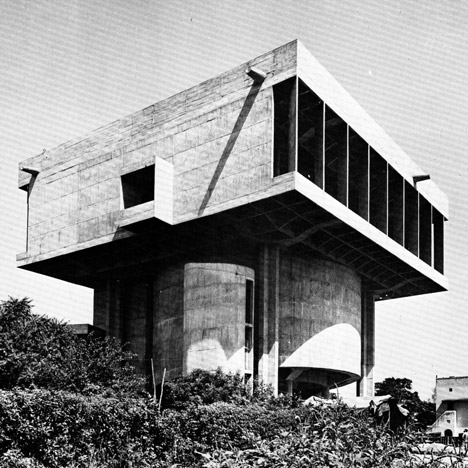
11 lesser-known Brutalist buildings that helped define the movement
Brutalism: as part of our series on Brutalism Dezeen invited Michael Abrahamson, editor of the F*ck Yeah Brutalism blog, to choose his favourite buildings.
Over the past three years operating the Tumblr blog F*ck Yeah Brutalism (FYB), the term has proven to be a surprisingly versatile yet also an enduring descriptor. To put it another way, it's hard to say what one means when using the term Brutalism, but one knows it when one sees it. I like to think of the images I've collected on FYB as a kind of visual definition.
While not all of the buildings that have appeared there fit the proper historical or conceptual frames for the term, what they share is a certain character – an exhibitionist's attitude to material and structure, a robustness of form, a transparency of function — that was undeniably prevalent in the architecture of Westernised and Westernising nations during the postwar years.
In spite of the truly global spread of these tendencies, most attention to Brutalism continues to focus on only a few superlative buildings in the UK and US. The word itself may be English, but the definition — in language or in pictures — need not remain so. What follows is a collection of nominees for a more inclusive and expanded Brutalist canon. They are arranged chronologically for the sake of expedience.
Owen Luder Partnership, Eros House, Catford, London, England, 1960
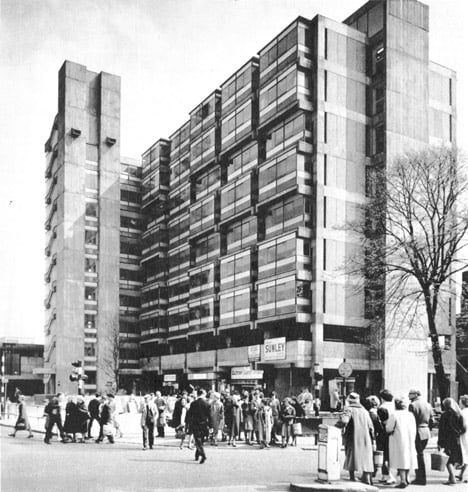
Eros House was the first major work by master Brutalist architect Rodney Gordon for the firm led by Owen Luder. The stair tower features continuous glass ribbons clad in translucent structural panes that reduce climbers to blurred silhouettes. Its asymmetrical arrangement became default for the many buildings of this type produced by Luder’s firm, though none came close to matching Eros House's heady mix of Constructivist faktura and New Brutalist literalism.
Gordon would go on to design other infamous buildings for Luder including Trinity Square and Derwent Tower in Gateshead along with the Tricorn Centre in Portsmouth, all of which have been demolished over the past decade. Eros House is listed, but renovations have reduced the impact of its once daringly transparent facades.
Gino Valle, Zanussi-Rex Offices, Pordenone, Italy, 1961
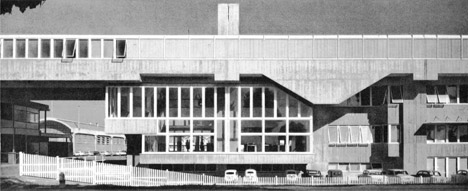
This once-famous building for an Italian appliance manufacturer adopts the rugged look of the utilitarian industrial sheds that surround it. Serving as the administrative center for a large manufacturing center, its offices terrace northward, affording a commanding view over the complex.
The south-facing street façade seen here features cantilevered shapes in exposed concrete that give its public face a graphic quality. Stocky stairways weave around and through the glass-enclosed lobby, which has since been shielded from the harsh sun with a fixed metal shade.
Förderer, Otto, Zwimpfer, Elementary School, Aesch, Switzerland, 1962
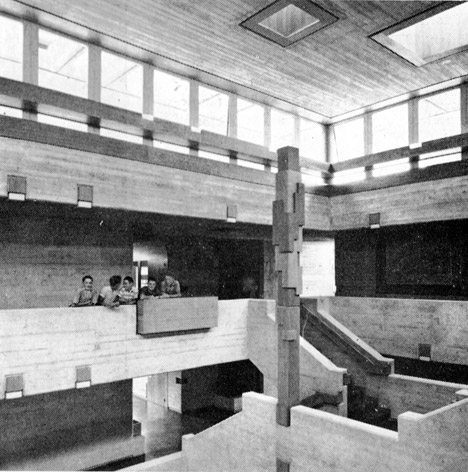
An accomplished sculptor as well as an architect, Walter Maria Förderer is best known for the sublime catholic churches he designed in his native Switzerland. With his collaborators Rolf Otto and Hans Zwimpfer, he also built a series of secular buildings over the course of the 1960s. Completed in 1962, this school complex for a small Swiss town near Basel features many of Förderer's architectural signatures.
What would in the hands of other architects be rectangular openings are instead cragged or crenelated, and exposed concrete is festooned with wood and metal insets for various purposes. Though this building did make an appearance in Banham's 1966 book The New Brutalism, the work of Förderer and his partners seems to receive little attention outside Switzerland.
Alfred Neumann, Zvi Hecker and Eldar Sharon, Town Hall, Bat Yam, Israel, 1963
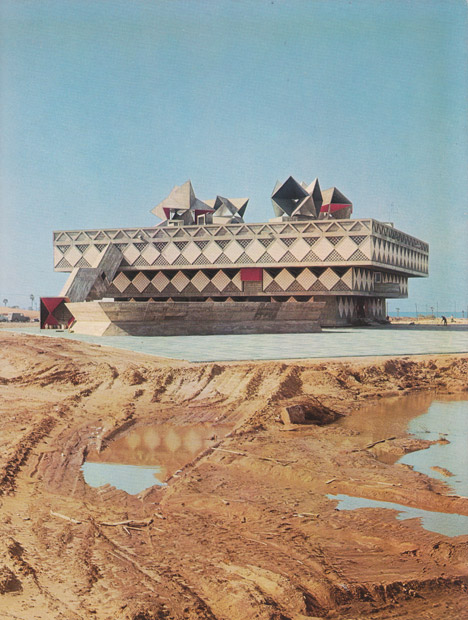
It may be a bit of a stretch to refer to this beguiling piece of architecture as Brutalist, but its inverted ziggurat form, exposed concrete structure, and rigorous geometrical composition certainly resonate with its Anglo-American contemporaries. Centering on a tenebrous atrium lit from above by wind-ventilated skylights, the building was critiqued for its aloofness and the claustrophobic nature of its offices, which lack transparent windows.
Nonetheless, it was viewed as important enough to the fledgling nation that it once appeared on a postage stamp. The four star-like polyhedrons standing astride the atrium's skylights presaged Neumann, Hecker, and Sharon's later modular housing experiments.
Sachio Otani & Taneo Oki, Religious Center, Tensho Kotai Jingu-Kyo Sect, Tabuse, Yamaguchi Prefecture, Japan, 1964
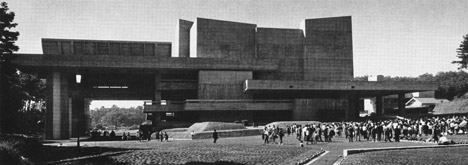
A disciple of Kenzo Tange, Otani is best remembered for his Kyoto International Conference Center, whose canted concrete walls and beams mimic the tectonics of traditional Japanese carpentry at a monumental scale. This dynamic complex of bulky vertical towers and broad cantilevered terraces is instead unapologetic in its modernity.
Built for a Shinto-based religion whose charismatic leader was born in the area, it is reminiscent of Denys Lasdun's National Theatre at London's Southbank Centre, but actually precedes that more famous building by several years.
Ahrends, Burton, Koralek, Theological College, Chichester, England, 1965
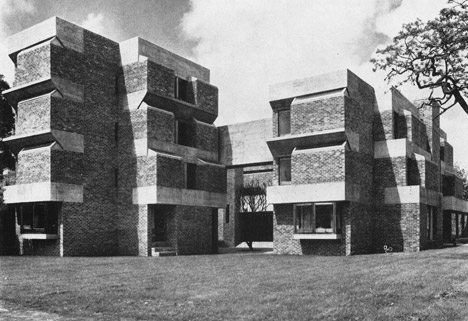
Like a steroidal version of Le Corbusier's Maisons Jaoul, the exterior walls of this cloistered college by the architects of Dublin's Berkeley Library bulge and protrude to create skylit study nooks in each dormitory room.
As this complex illustrates, Brutalist characteristics were found not only in the monumental or institutional but also the modest and relatively domestic. It also illustrates that in addition to their structural exhibitionism, many Brutalist architects also pursued ingenious ways to bring natural light into otherwise fortress-like buildings.
John Andrews, Humanities and Science Wings, Scarborough College (Now University of Toronto Scarborough), Ontario, Canada, 1963-66
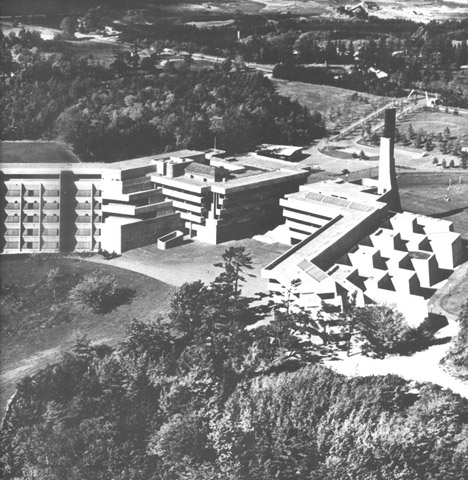
Informed by the urban thinking of Team 10 and by the site's location on a U-shaped ridge, Andrews' precocious masterplan and buildings for Scarborough College offer a compelling example of the Brutalist megastructure. That these were the Australian architect's first independent commissions — completed before his 30th birthday — only adds to their allure.
Centering on an open court between the two wings, the complex branches outward, with the sciences terracing down and the humanities built atop the ridge. Each is traversed by an enclosed pedestrian street. Like most supposedly growth-oriented master planning projects of the 1960s, subsequent development has compromised the clarity of Andrews's organization, but the majestic, almost geological presence of these first wings remains powerful.
Emilio Duhart (w/ Christian De Groote and Roberto Goycoolea), United Nations Building (now Economic Commission for Latin American and the Caribbean), Santiago, Chile, 1966

Easily the most Corbusian building included as part of this list, this UN building is clearly influenced by the master's late work, especially Chandigarh's Palace of Assembly and the monastery of La Tourette. Yet Duhart's design is also inflected by climatic needs, seismic requirements, and local building traditions.
Inside a suspended square of offices, a large courtyard is broken into four parts — similar in scale to Chilean courtyard houses — by several firmly grounded, semi-autonomous figures accommodating particular functional needs. Access from these central parts to the offices is via second-level bridges. The concrete surfaces facing these courts are given a variety of treatments, including decorative reliefs that adorn the spiraling, snail-like assembly chamber.
John M. Johansen, Goddard Library, Clark University, Worcester, Massachusetts, 1967
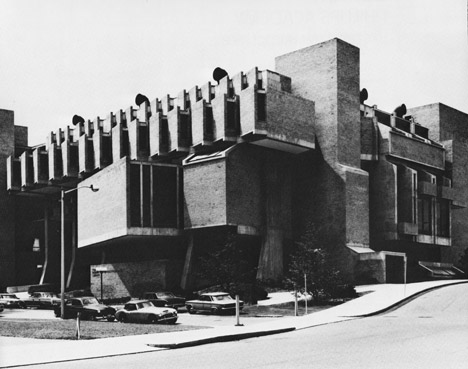
One critic compared this seemingly informal jumble of functional parts to "the backside of a refrigerator". Bringing parts together in irregular arrangement, Johansen tried to achieve an ineloquent, slang-like architecture informed more by circuit boards, highway overpasses and oilrigs than by Le Corbusier.
Impressive though the Goddard Library may be, it was in some ways a dry run for the formal strategy deployed in Johansen's even more dramatic Mummers Theater in Oklahoma City, a flawed masterpiece that was recently demolished after years of uncertainty. An important figure in American architecture during the 1960s, Johansen left the spotlight as his convictions became more zealous and his ideas less pragmatic.
Ulrich Franzen, Alley Theater, Houston, Texas, 1968
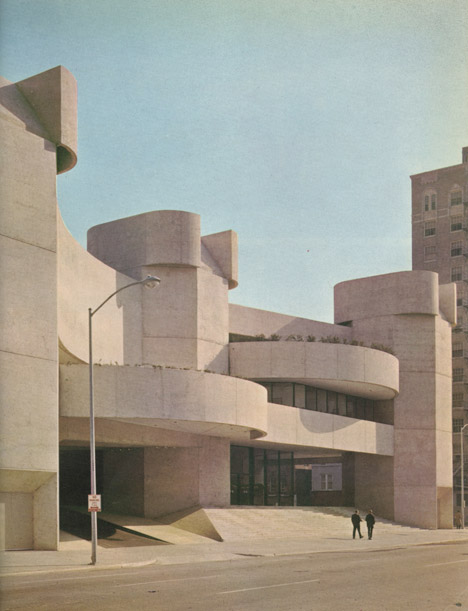
Trained at Harvard during its postwar years under Walter Gropius, Franzen was a classmate of I M Pei, Ed Barnes, Paul Rudolph, and Johansen. Rejecting the stale "modernism" of Lincoln Center's uninspiring theaters, Franzen here favored an interpretation of the American Southwest's dramatic geography and vernacular building traditions.
The Alley's fluid, curvilinear exterior is somewhat like an exposed concrete Guggenheim, albeit one punctuated by imposing octagonal turrets. Appropriate for car-crazy Houston, one can buy tickets via a drive-through ramp. One of the only bright spots for Brutalism this year was the announcement that a nearly $50 million renovation and update is underway at the Alley, to be completed in 2015.
Shiv Nath Prasad, Shri Ram Centre for Art and Culture, New Delhi, India, 1969
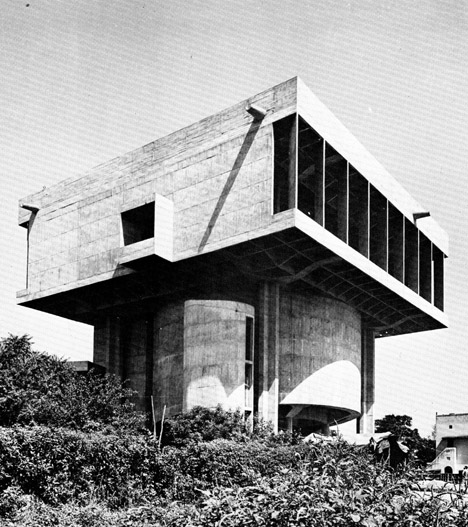
Though an avowed Corbusian, Prasad was in fact educated in the UK in the early 1950s. He eventually rose to become a master planner of New Delhi before leaving the civil service for private practice. Located near one of New Delhi's main chowks this virtuoso display of Prasad's structural and sculptural skill houses a performance space affording especially close proximity between audience and stage.
Its cubic exterior features a cantilevered upper level atop curvilinear figures housing exit stairs and the performance space itself. The upper level is shaded by deep brise soliel, and reveals its complex waffle structure.
Michael Abrahamson is a doctoral student in Architecture History and Theory at the University of Michigan. Prior to his enrollment at Michigan, Michael taught architectural design, theory, and history at Kent State University. He has published criticism in numerous journals, and is a frequent contributor to CLOG, for whom he guest edited the February 2013 issue on Brutalism. He also operates a Tumblr blog called F*ck Yeah Brutalism.